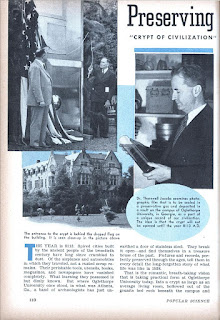viernes, 3 de julio de 2020
Crypt of Civilization
Preserving Our History in a Tomb
“CRYPT OF CIVILIZATION” WILL RE-CREATE OUR DAILY LIFE FOR PEOPLE OF 8113 A.D.
THE YEAR is 8113. Spired cities built by the ancient people of the twentieth century have long since crumbled to dust. Of the airplanes and automobiles in which they traveled, not a rusted scrap remains. Their perishable tools, utensils, books, magazines, and newspapers have vanished completely. What learning they possessed is but dimly known. But where Oglethorpe University once stood, in what was Atlanta, Ga., a band of archaeologists has just unearthed a door of stainless steel. They break it open—and find themselves in a treasure house of the past. Pictures and records, perfectly preserved through the ages, tell them in every detail the long-forgotten story of what life was like in 1938.
That is the romantic, breath-taking vision that is taking practical form at Oglethorpe University today. Into a crypt as large as an average living room, hollowed out of the granite bed rock beneath the campus and lined with walls of gleaming chromium, experts are stuffing motion-picture films, copies of present-day encyclopedias, textbooks, works of art, and models of machines that will give future historians a complete picture of their distant ancestors.
When the crypt is filled, the air in it will be replaced with inert nitrogen gas, and it will be sealed against the ravages of the ages. Graven in a plaque upon the stainless-steel door, a message will direct that the vault be opened in 8113—a date chosen because it is as far in the future as the first recorded date in history, the beginning of the Egyptian calendar, is in the past.
For the first time, points out Dr. Thornwell Jacobs, president of the university and originator of the project, the art of copying books and pictures in reduced size on movie film permits storing a vast bulk of priceless records in limited space. Duplicate “microfilm” copies of volumes for the Georgia vault are being made upon standard cellulose acetate film and upon tissue-thin metal film, a new invention that is believed still more durable. To prepare it, the image of the negative is etched into stainless steel, nickel, or copper by photo-engraving methods. An inlay of another metal, such as platinum, is then deposited in the etched portions. The result is an indestructible picture on metal in black upon a white background.
Five rolls of film, surrounded by inert gas, are sealed in a glass tube. Protected by a layer of asbestos, the tube in turn is placed in a seamless receptacle of stainless steel, a foot long and four inches in diameter. The receptacle itself is inclosed in a ribbed casting of extra-strong alloy, capable of resisting a crushing force of thousands of pounds. Row upon row of these receptacles will line the metal shelves of the crypt. Barring accident, their contents should be found in perfect condition after sixty centuries!
Suppose the location of the vault is for- gotten with passing centuries? Descriptions of the deposit, engraved on metal, will be placed in all the great libraries and museums of the world, and even in such out-of-the-way places as monasteries in Tibet and temples in China and India! Some one of these clews will almost inevitably be discovered. If English is an unknown tongue by 8113, how can the records be deciphered ? The first thing to meet the eye of a person entering the vault will be a movie machine of the pioneer “mutoscope” type, with the addition of a phonograph attachment. Turning a crank reveals one of 3,000 metal plates, bearing, say, a picture of an apple and “APPLE” in print. Sound apparatus then pronounces the word.
Since no one knows what sort of electric current people will use in 8113 A.D., if it is available at all, a windmill generator will provide current for the electric sound-film projector.
Records to be stored away will include sound films of the voices of present-day leaders, stereoscopic photos of all the world’s masterpieces of sculpture, a year-by-year history-in-pictures of the United States for the last 100 years, and the world’s greatest masterpieces of poetry. Models will show every essential kind of modern tool and machine, household utensils and tableware, and great engineering feats. A complete set of costumes for men and women will be preserved in helium gas. There will be cook books, histories, science textbooks, and books of practical instruction in mechanics, engineering, and all the arts and manufactures. Two Popular Science handbooks are to be included. Supermen of 8113 may be chagrined to find that some of their inventions were anticipated as early as the twentieth century. Or, if world war or some natural cataclysm has made mankind revert to a barbaric state by that time, the “lost arts” preserved in the Georgia crypt might conceivably start the race back along the road to civilization."
Popular Science, December 1938
Suscribirse a:
Enviar comentarios (Atom)





No hay comentarios:
Publicar un comentario